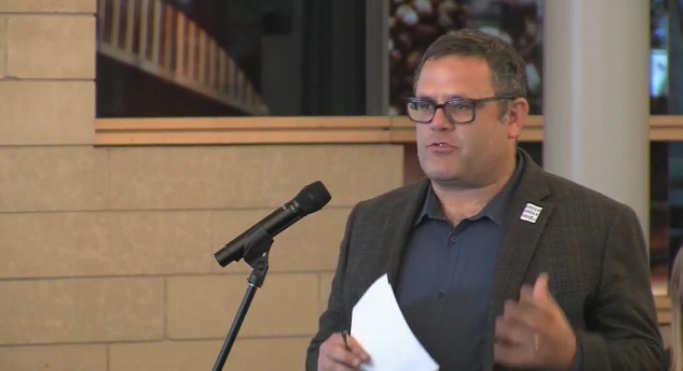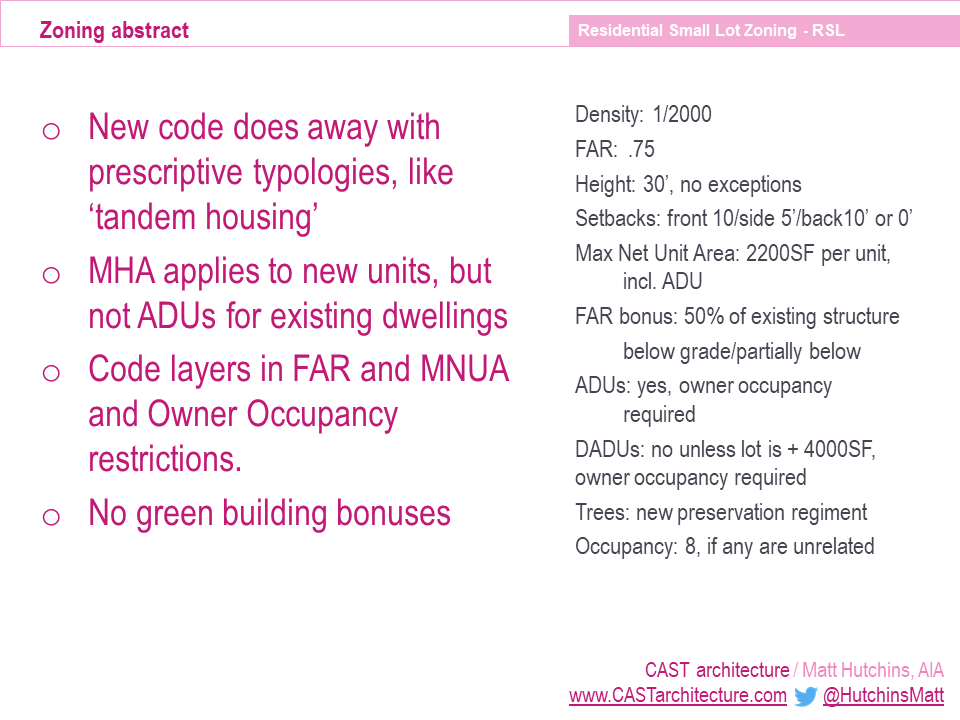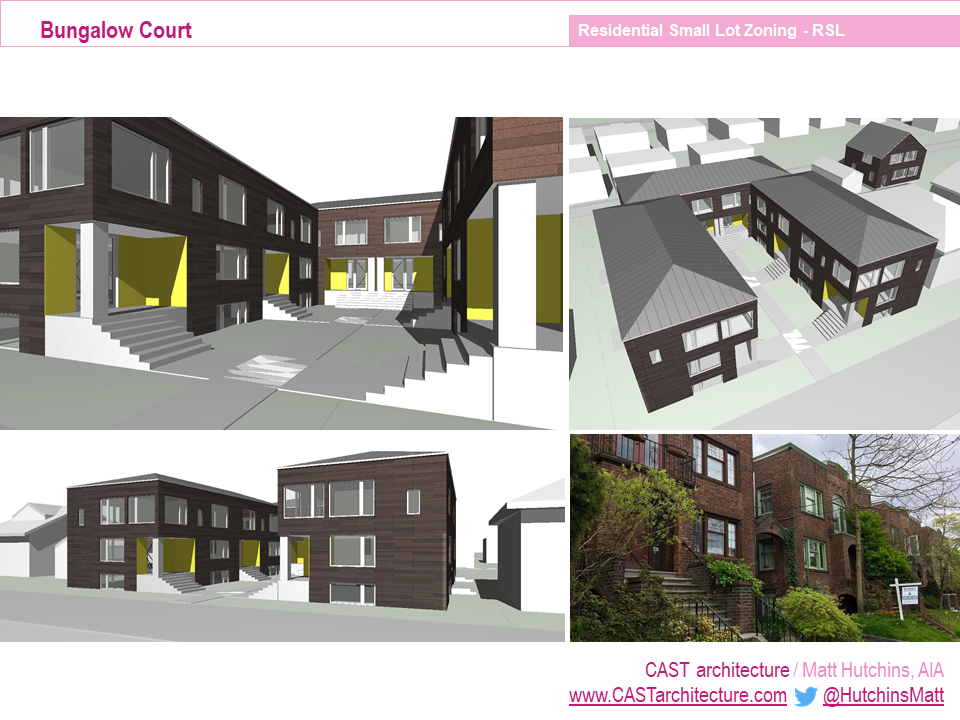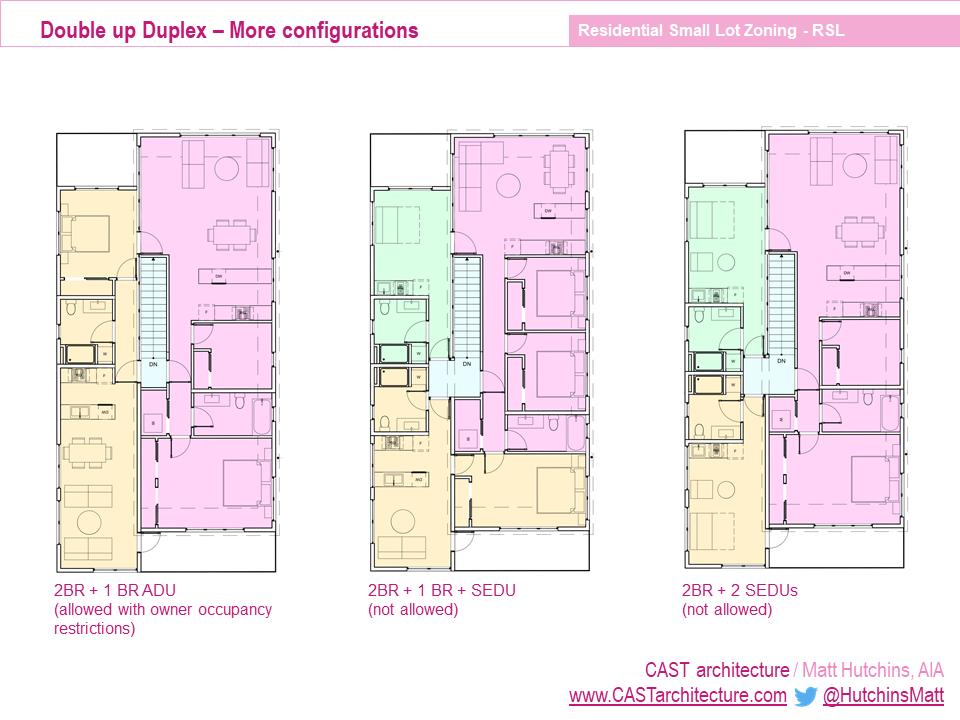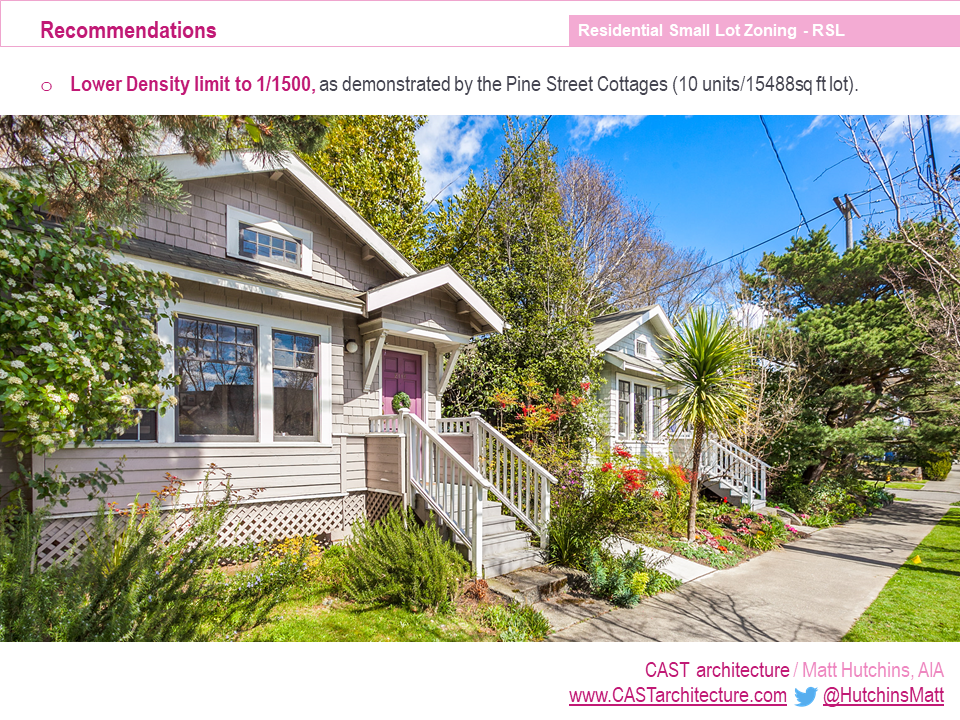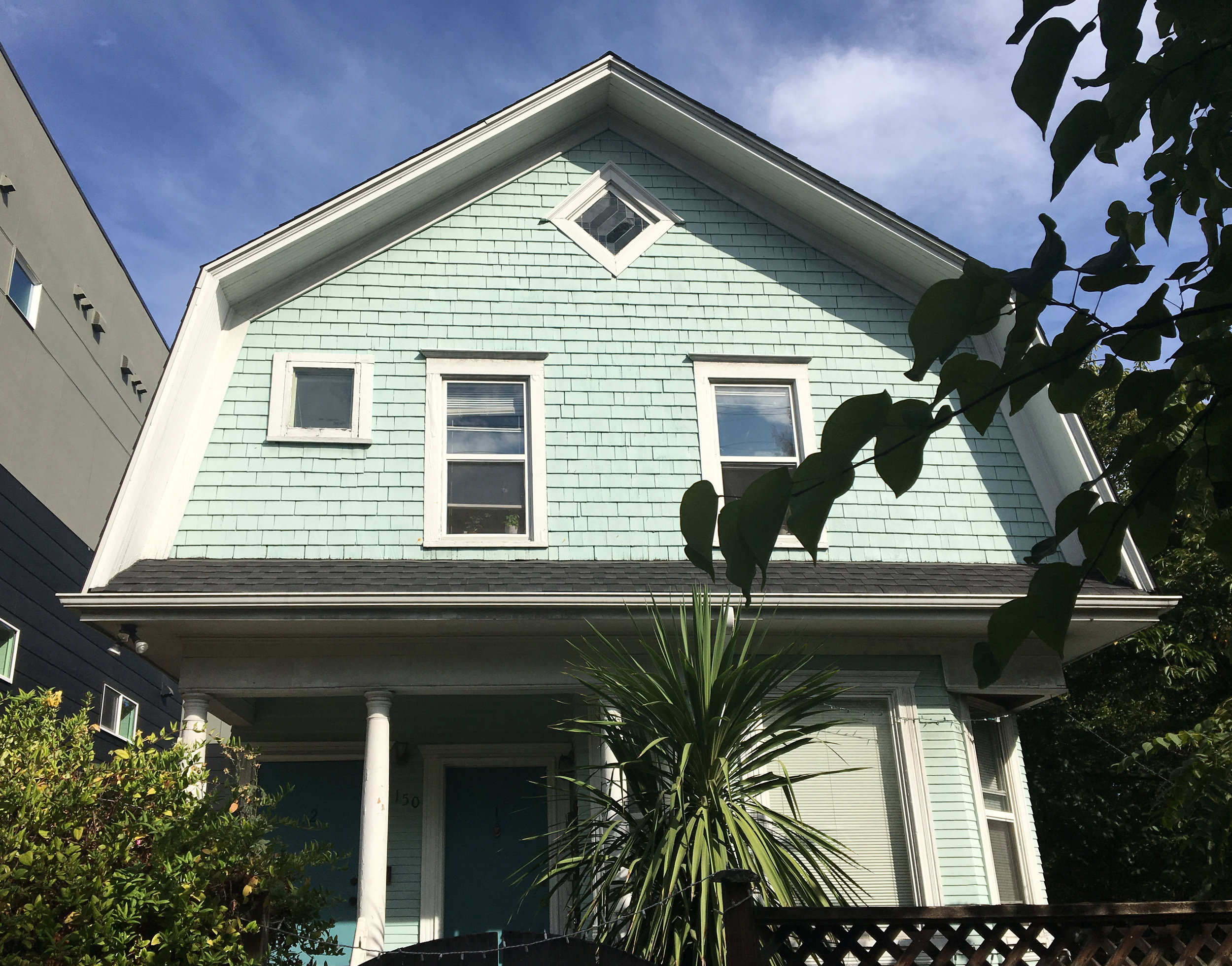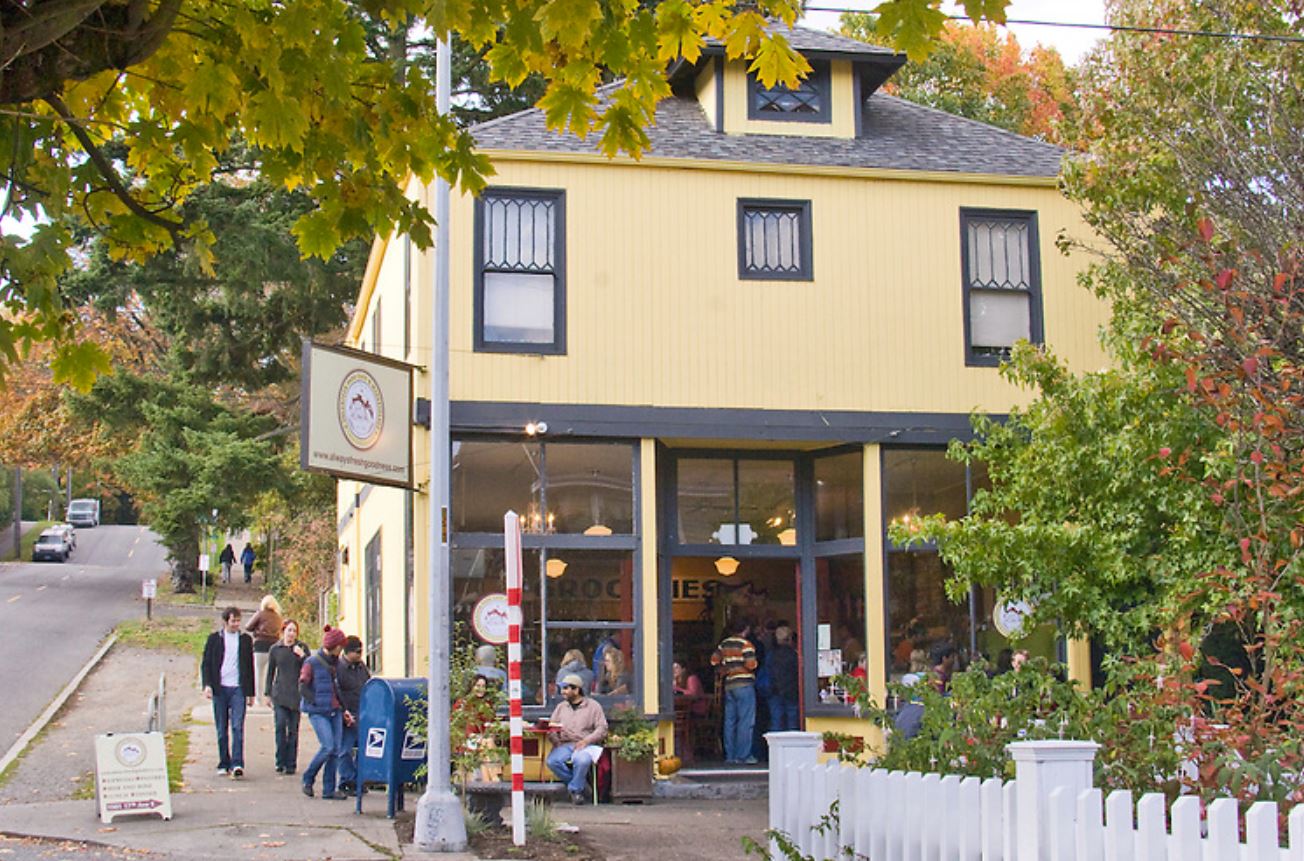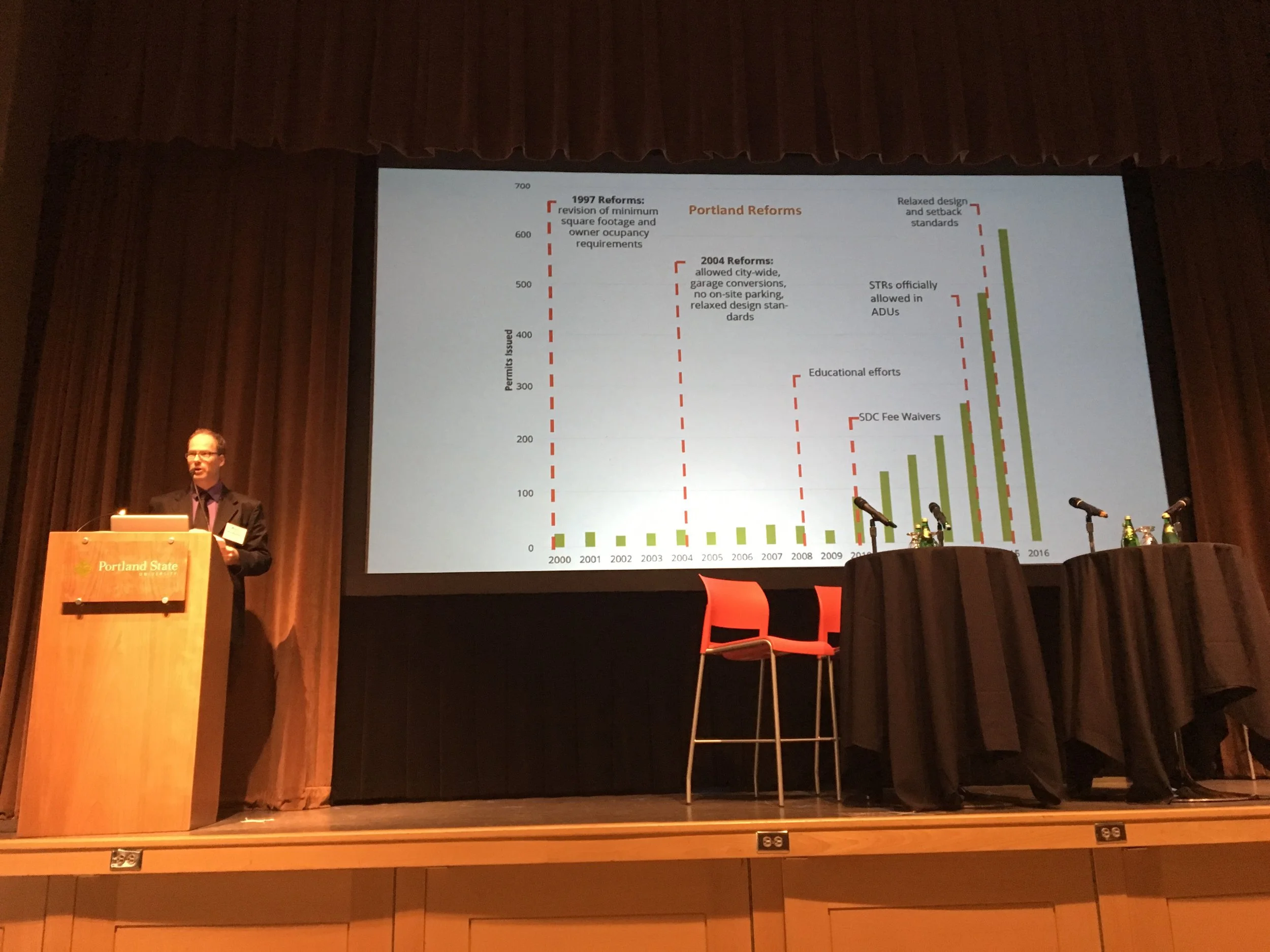Steelaway Cottage is finished! Clad in weathering steel, don’t let the tough exterior fool you! It is a very ‘hygge’ —Danish for that ‘cozy’, clean, well lit style— inside. At 800 square feet, it has still has 2 bedrooms, 2 baths, but it is snug as you might expect.
Seattle is going to change thousands of residential lots from ‘Single Family’ to ‘Residential Small Lot’ (RSL) as part of the MHA zoning reform. The rules covering RSL have been totally rewritten and there are many questions about how it will affect our neighborhoods, including most of South Park.
First, what is RSL and what kinds of new development are we likely to see?
Second, how does RSL address displacement, affordability, density or sustainability?
Finally, how can we improve RSL so that it can be the most effective before the ordinance comes before Council?
If you live in an urban village or are interested in innovative infill housing, join Matt Hutchins, AIA for this informational talk: Follow the link below to RSVP. Thanks!
https://www.eventbrite.com/e/envisioning-seattles-residential-small-lot-future-tickets-51155568683
Steelaway Cottage, by CAST architecture 2018
To celebrate the final Environmental Impact Statement that came out last week, we’d like to highlight some of the less obvious but clear reasons for progressive Seattle to embrace the new ordinance covering Accessory Dwellings.
1. Many ADUs end up being affordable, even if they are admittedly expensive to build. I have made the case over and over that we should approach ADUs with our eyes open as to the cost and not put too much faith in them as a cure-all for our housing crisis. But, in surveys collected from Vancouver, Portland, Ashland, Eugene, Edmonton, the Bay Area, a large percentage (generally around 20-25%) of accessory dwellings end up being rented for nothing, very little or well below market rate. Voluntary affordability, where the owner has prioritized the benefit of having family, friends, or even good tenants as neighbors over the potential rent they could demand if they were more ruthless landlords is a major benefit of this form of housing.
Voluntary Affordability in Portland. https://accessorydwellings.org/2014/08/07/do-adus-provide-affordable-housing/
Voluntary Affordability in Edmonton. https://accessorydwellings.org/2017/09/08/garden-suites-in-edmonton-a-private-investment-in-the-public-good/
For example, I have friends who have not raised the rent in 9 years for their upstairs mother-in-law apartment because they love the tenant but she’s on a fixed income. It’s a sweetheart deal they want to last as long as she can handle the stairs. These anecdotes are the rule for homeowners who’ve ‘DIY’ developed an extra unit on their property.
In Portland among owners who live in their ADU, 41% of the primary residences where offered for FREE. Meanwhile, we’re fighting tooth and nail over an inclusionary zoning program that might create 6–10% of new housing as rent restricted. The reality is that a naturally occurring housing type people desperately want to build all over is also 2 1/2 times more likely to create truly affordable housing than our best big policy idea.
2) Making Mother-in-Laws and cottages pencil financially counters wild speculation on McMansions. In the Draft EIS, the City ran different financial models for potential development outcomes. In the draft EIS, 46% of the possible scenarios resulted in tear down/replacement McMansions being the most profitable investment. It was only in cases where the land value was high and the lots were large that adding an ADU and DADU made sense. But if you value the neighborhood and want to curb the momentum of displacement and gentrification, supporting options where a second or third household can add rental income suddenly flips the proforma against the disruptive scourge of McMansions.
3) Renters are Seattle’s majority and any related stigma is out of touch. Owner occupancy restrictions are the biggest impediment to the creation of more housing and keep lower income renters out by limiting the number of options for less expensive dwellings to exist. The checkered history of zoning as a substitute for outlawed racial or class covenants is well documented.
More than 20% of Seattle houses are already rentals. We don’t have a restriction on renting out a detached house and has very few expectations of landlords (more might be in order) yet neighborhoods still thrive. Both tenant and landlord are by and large responsible neighbors. Ask any renter, and they will tell you that they are just as committed as property owners to the neighborhoods, support the local businesses, and participate in civic life. As the majority of Seattleites, renters make up the underlying tax base that funds our government, parks, police, and transit (renters pay property taxes too, just through rent).
4) Besides, owner occupancy restrictions should be illegal. Limiting WHO can use land, as opposed to what the land’s function is isn’t really the job of the land use code. Making property ownership the prerequisite to use is unique to ADUs and has been challenged elsewhere. Other jurisdictions, such as Alberta Canada explicitly allow residency without ownership wherever residences are allowed for that reason.
Find the duplex! (Answer below)
5) Finally, extra dwellings are already everywhere. While people might worry that allowing a ADU and a DADU without owner occupancy restrictions will lead to no less that the ‘destruction of our most unique resource, Seattle’s single family neighborhoods,’ the reality is that there is a long history of small multi-family dwelling coexisting with and even predating the now dominant paradigm of stand alone houses for solitary households. Turn of the last century neighborhoods, like Queen Anne and Wallingford (pictured above), valued for their amenities, walkability, and housing stock, were developed mostly before zoning. They are filled with the highest concentration of small multifamily buildings, house more than 10,000 households, but you might never know it from the street. Honestly that is part of their charm and vitality. If the worst thing is that there are a few more families per street, I think our neighborhoods are more than resilient enough to handle it.
Every dot is at least one extra household that doesn’t need a stand alone house.
*In the photo above every structure is a duplex, triplex or fourplex, with the exception of the tallest white structure on the left.
We are hiring again, this time for an Entry Level position. If you want to join our team, here is the job description:
The candidate will work under the direct leadership of a principal/project manager and will assist with all aspects of the design and production of residential, commercial and public architectural works. Additional duties may include some production of marketing materials as needed.
Qualifications:
• First and foremost you are an exceptional designer who excels working in a collaborative and creative environment
• A ‘can do’ work attitude on all tasks from the mundane to the extraordinary
• Solid verbal, written, and graphic communication skills in order to evenly manage day to day affairs with clients and contractors
• Open to learning the technical aspects of materials use, construction techniques and details, especially light wood framing and building envelopes.
• Ready to dive in with Seattle’s DCI Project Portal and bend it to our will!
• A Bachelors or Master’s degree in architecture from an accredited university is required.
• Architectural license not required.
• Experience with BuiltGreen, LEED or Passive House would be beneficial.
• 0-3 years of experience.
Technical skills:
• Proficient with architectural drafting software, preferably ArchiCAD (Note – we do not use AutoCAD). We will train if you don’t have ArchiCAD experience but are ready to learn.
• Proficient with Sketchup
• Highly proficient with Adobe creative suite, with an emphasis on Photoshop and InDesign
• Familiar with Microsoft Office suite, emphasis on Word and Excel
CAST architecture is a small full service architectural firm specializing in residential design and small scale public and commercial works. Our office is friendly and low-key. We enjoy working collaboratively, have a tradition of Friday afternoon design crits, and actively foster a team approach in all of our endeavors. We pride ourselves in promoting a healthy work/life balance and passions and interests outside the office.
Submit a cover letter, resume and samples of design work digitally to employment@CASTarchitecture.com. We will review and respond to everyone by October 30th at the latest.
No phone calls or hand-delivered applications please.
We are hiring again, this time for a Project Architect. If you want to join our team, here is the job description:
The candidate will work under the direct leadership of a principal/project manager and will assist with all aspects of the design and production of residential, commercial and public architectural works. The candidate will be tasked with collaborative design with a principal through Schematic Design, then be responsible for Design Development, Construction Documents, Permitting and Construction Administration. Additional duties may include some production of marketing materials as needed.
Qualifications:
• First and foremost you are an exceptional designer who excels working in a collaborative and creative environment
• A ‘can do’ work attitude on all tasks from the mundane to the extraordinary
• Solid verbal, written, and graphic communication skills in order to evenly manage day to day affairs with clients and contractors
• A well rounded understanding of the technical aspects of materials use, construction techniques and details, especially light wood framing and building envelopes.
• Able to reliably estimate design time required for a project, and meet promised schedules.
• A firm grasp of Seattle’s Land use and building codes, as well as permitting requirements.
• Ability to complete a single family residential construction document set with minimal oversight.
• Ability to successfully navigate Seattle’s DCI with minimal oversight.
• A Bachelors or Master’s degree in architecture from an accredited university is required.
• Architectural license preferred but not required.
• Experience with BuiltGreen, LEED or Passive House would be beneficial.
• 5+ years of experience.
Technical skills:
• Highly proficient with architectural drafting software, preferably ArchiCAD (Note – we do not use AutoCAD). We will train if you don’t have ArchiCAD experience but are ready to learn.
• Highly proficient with Sketchup
• Highly proficient with Adobe creative suite, with an emphasis on Photoshop and InDesign
• Familiar with Microsoft Office suite, emphasis on Word and Excel
CAST architecture is a small full service architectural firm specializing in residential design and small scale public and commercial works. Our office is friendly and low-key. We enjoy working collaboratively, have a tradition of Friday afternoon design crits, and actively foster a team approach in all of our endeavors. We pride ourselves in promoting a healthy work/life balance and passions and interests outside the office.
Submit a cover letter, resume and samples of design work digitally to employment@CASTarchitecture.com. We will review and respond to everyone by October 30th at the latest.
No phone calls or hand-delivered applications please.
Matt will be presenting at a ADU conference put on by Portland State’s Urban Sustainability Accelerator.
Public Support Strategies: NIMBYs, YIMBYs and Decision-Makers
A recent column in the New York Times described research showing that opposition to infill and redevelopment in single family neighborhoods was bi-partisan and pervasive and was playing an important role in limiting housing supply in expensive housing markets. That opposition can often be decisive for decision makers as they consider changes to land use regulations or reviewing permits. Yet progress on this front has been made using different public support strategies, including responsible journalism and the formation and effective advocacy by Yes In My Backyard organizations. This session will hear from advocates with YIMBY groups Portland for Everyone and MOAR Seattle (More Options for Accessory Residences) and the roles these groups have played in pushing for reforms to single-family zoning. Teams will share what they have observed as the most effective responses to neighborhood opposition to ADUs and other forms of infill and redevelopment.
Small scale courtyard apartments like these would be allowed in urban centers and villages
I'll be giving a couple of seminars on the potential and pitfalls of the Residential Small Lot Zone, a feature of the MHA ordinance, set to replace single family zoning in urban villages. It make be a new zone, but it harkens back to very traditional housing forms of gentle, low rise 'missing middle' housing that was downzoned out of existence over the last couple generations.
1) August 8th @ 6-8pm at 12th Avenue Arts. Sponsored by the Capitol Hill Renter Initiative
2) October 2nd from 6-8 at South Park Hall. Register Here:
https://www.eventbrite.com/e/envisioning-south-parks-new-residential-small-lot-zoning-rsl-tickets-48677525790
We are very excited to be involved in a fantastic affordable housing project in collaboration with the Methow Housing Trust. We are going to to be rolling out two and three bedroom houses along Canyon Street in Twisp, perfect for workforce housing or elderly residents--two demographics that are often the first to lose out when demand for housing is running up prices.
RSL Walk ups and cottage developments create a neighborhood within a neighborhood.
Seattle is facing a housing shortage, a climate crisis, and an increasingly inequitable city. Allowing more dwelling options, at various sizes and price points, is a great strategy to combat all three. Enter the Residential Small Lot Zone, Seattle’s attempt to add less expensive dwellings in dense, amenity rich urban centers without disrupting the historical fabric of single family detached houses.
As part of Mandatory Housing Affordability (MHA), Seattle is rezoning many of the Urban Village parcels currently zoned ‘Single Family’ to ‘Residential Small Lot‘ (RSL). RSL exists under the code right now, but is applied to only 7 acres of zoned land in Seattle and has narrowly defined housing types and restrictions that have kept it from wider acceptance. Under MHA, RSL will be expanded to 768 acres and include about 6200 Single Family Lots. The proposed code has been rewritten from the ground up, so let’s dig in and see what it is likely to produce for Seattle’s neighborhoods.
Function
Reading the definition of RSL, it is hard not to feel sorry for this hard working zone.
It has to be a little of everything to everyone. It is uncommon for a zone description to get into issues of affordability, children, and the desires of its residents. We don't expect the description of General Industrial 2 (IG2) to make judgments about dockworkers’ life choices. Or Downtown Office Core-1 (DOC-1) to wonder about whether people in Downtown Office Core 2 (DOC-2 ) feel development there is appropriate.
Nevertheless, it exposes a question. What is the mission of RSL? Is it a transition between Residential zones? Is it meant to capitalize on the proximity to urban centers by putting residents close to amenities, jobs and transit? Is it fighting displacement, or fostering density? What need does it serve, and what is the positive vision of that zone? Right now, it is formulated with a little of everything, including some new stuff, and takes elements from single family, multi family, bridges residential and building code with a dash of high minded mission to address family housing and affordability. It is a little like this:
RSL. Not elegant, but adapted to its environment.
The Nitty Gritty: What does it look like on paper?
What does RSL look like?
Before RSL zone, this Single family zoned street has 28 dwellings.
And again, after a generation of development doubles the number of dwellings:
57 dwellings on the street, double the current density, but not much change at street level.
Prototypes for RSL Zoning
We've taken the liberty to suggest some prototypes, based on traditional 'missing middle' multifamily, optimized for this zoning.
Bungalow Court (or the Walk Up Model)
For lots greater than 11,699 sq.ft, this bungalow court has (6) 3BR 1466 sq.ft. primary units, and (6) 733 sq.ft. 1 or 2BR ADUs. This walk up is really a module that can be arranged into twos, threes, any grouping based on density limitations.
Double Up Duplex
Our idea is for a stacked duplex, 1500 sq.ft. configured for an ADU, optimized for the allowable FAR on a minimum 4000 sq.ft. lot. We'd target Passivhaus green building standard, integrate green roof, pv, and rainwater catchment.
Alternative configurations for ADUs, or future co-housing options.
Recommendations for code tweaks!
Here are fourteen ways we can improve the Seattle’s MHA’s totally rewritten Residential Small Lot zone, BEFORE it goes into effect:
1.Exempt RSL from MHA fees. New dwellings created in the RSL zone will be subject to MHA, but will anyone built a rent restricted house? No. Therefore, fees due at permit issuance could be as high as $45,650. It will have a dampening effect on any homeowner looking to build a second house on the back of their lot. Many of those homeowners will build an ADU instead (not subject to MHA fee), eliminating the upside of more smaller homes in the marketplace.
2. Allow ADUs to function as MHA performance! MHA performance is 50% for lots under 5699 sq. ft.. Meanwhile ADUs are by definition limited to a smaller size, and making them affordable would be closer in spirit to the original intent of the ordinance.
3. Eliminate new Maximum Net Unit Area limit. Maximum Net Unit Area is a new, unique limitation that only applies to this zone, and nowhere else. It is Floor Area per Unit, and it is often in conflict with the Floor Area Ratio (FAR) for the parcel. There are no MNUA exceptions for existing houses or additions, meaning many of Seattle’s classic bungalows in RSL zones will suddenly become non-conforming, unable to do a ‘bump out’ or even a SECOND story addition. Because basements count toward MNUA, but not FAR, expect a lot of new buildings with basements apartments.
A basic RSL block reveals surprising inflexibility unless you want to add a second dwelling
The owners could only do a 230 sq. ft. addition. Not a second story. They could however build a new dwelling behind it up to 2200 sq. ft.
4. Start FAR at 1, give .25 bonus for more dwellings. The FAR is .75, lower than any Low Rise zone, and effectively lower than Single Family zoning (only governed by height and lot coverage). If RSL is meant as a transition between multifamily and single family, it is more restrictive that both.
5. Lower the density ratio to 1 to 1500. Fourteen percent of the newly minted RSL lots will not even support a second dwelling. Why go through this process then wipe the development capacity of 900 lots off the table? Rounding up for density at 1.85 * 2000SF means any lot under 3699SF is still a single family lot, but MNUA effectively limits all dwellings to an FAR as low as of .59.
6. Allow more than one Accessory Dwelling Unit (ADU). All these lots are in urban centers, where we are planning to put almost all our growing population. Many lots or owners aren’t going to want to built a full second dwelling. Meanwhile, SFZ will soon allow two ADUs per primary residence. This flexibility will preserve many existing houses, and provide homes for new residents right in the urban villages.
7. Exclude ADUs from MNUA. An accessory dwelling unit counts against the MNUA, meaning many average houses wouldn’t be able to build a cottage without sacrificing square footage in the primary house.
8. Resist the urge to Design Standard. The two Design Standards for RSL are ridiculous. Different color walkways to the house in back? Why? We don’t expect such ham fisted wayfinding in multifamily zones where there’s likely more front doors. One of the great strengths of the proposed code is that it did away with the many of the restrictive types, like ‘tandem housing.’ Let’s not dilute it with well meaning micro management, only to find out that we’ve created a less than graceful solution (remember the platypus!).
9. Allow exceptions from MHA when preserving existing houses. Subdividing existing houses into multiple units will be penalized by the Design Standards, and be subject MHA fee, at the full price for the area of units. The MHA fee calculation is gloss floor area/total units X net increase of units. A 3000 sq ft house, converted into a triplex from single family, would pay MHA on 2000 sq ft as if new, or up to $41,000. That neither incentivizes preservation or the creation of more affordable housing.
This is a triplex. Converting it under the MHA regime would cost tens of thousands of dollars in MHA fees in addition to the requirements of retrofitting.
10.Take out limit on number of apartments. The stigma of apartment living results in one of the most efficient (and revered) forms being outlawed. The code is clear: RSL outright outlaws more than three apartments regardless of lot size. No cute Capitol Hill fourplexes.
This fourplex is not allowed under the new RSL zone.
11. Eliminate owner occupancy requirements. We don’t require owners to live on site in other multifamily zones, owner occupancy requirements will severely limit the number of accessory dwelling units and they reinforce a fundamentally class based stigma against renters.
12. Change all residential zones to ‘Residential’. We now have three titles for zones where residences are the only use; Single Family, Lowrise, Residential Small Lot. While RSL is being treated as a unique bridge between SFZ and LRZ, it should be part of a continuum of dwelling per square foot. Streamline!
13. Amend Seattle Residential Code to cover up to four apartments. Building codes switch to the more demanding SBC for anything more dense than a duplex and ADUs are considered as such. When buildings should be getting more efficient, like stacking a third apartment on top of a double decker, there is a quantum leap in construction cost, driven by code compliance.
14. Allow Live Work and Corner stores. In midrise zones, having residential suites at the street level seems forced. Two blocks from the center of an urban village, having an office space legible from the street makes total sense. Allowing corner stores would expand the walkshed so more people will walk to pick something up, rather than drive to a supermarket.
Neighborhood institutions start with entrepreneurial neighbors. Give them a place.
Regulation isn’t the only issue keeping ADUs from widespread adoption.
This past weekend, I attended the Build Small Live Large 2017 conference, a national meetup for policy makers, builders, architects and advocates involved in Accessory Dwelling Units (ADUs). People came to share ideas, learn from industry leaders, and see how to jump start more accessory dwelling units in their own neighborhoods. I’d like to distill a couple of themes I heard over and over.
Reducing regulation works.
Portland has incrementally reduced regulatory barriers to ADUs, allowing them without owner occupancy since 1997, yet only a handful were built every year. It wasn’t until they waived impact fees (up to $15000) and relaxed size and design limitations that production took off. (1)
In California, a new state law mandated local jurisdictions allow ADUs. Under the new rules, San Francisco’s building permits jumped from one or two a month to twenty five or more the first month. In Los Angeles, permits have jumped tenfold. They now are projecting nearly 2000 next year (vs. 142 in 2016). (2)
But reducing regulation isn’t enough.
Many jurisdictions allow ADUs but they haven’t taken off. After eight years of legal use, Seattle is just starting to see a slow uptick. Perhaps because their location makes them less visible, many people don’t know what they are, where they are, and if they’re allowed.
Part of the Portland success story has been education. For years, advocates like Kol Peterson have been hosting public tours. When a thousand people sign up and you have to turn people away, you know your community has reached a critical mass where everyone knows someone who has one or has lived in one.
Nearly all ADUs are created by homeowners, and nearly all of them are amateur developers, in that they have never build anything before. In other communities, they need resources to understand the process, cost, etc. Cities can step in here and give a giant hand by creating ADU specific webpages, checklists for permits, tips. Stock plans and prefab may be options (although in my experience are of limited use once unless the site, access and owner needs are a good fit).
ADUs are expensive, but less expensive than anything else.
While Accessory Dwellings are the most cost effective way to add households to existing neighborhoods, that doesn’t make them automatically affordable. They are only less expensive in comparison to other housing options, mostly because they are either smaller than other options, or are carved out of existing housing. Unless we support steps to make their construction less expensive, or their financing less risky, we’ll continue to see only a few built.
Making construction and permitting less expensive is another article, but I want to focus on just one statistic by Jake Wegmann, Assistant Professor in the Community and Regional Planning program at the University of Texas at Austin. In a study of 414 ADUs in Portland, Seattle and Vancouver, about 85% of homeowners used equity, cash or other personal resources to finance construction, whereas less than 5% were able to borrow against future value (or rental income, unlike any other rental property type). Today’s new ADU is almost exclusively the providence of those with significant resources at hand. Limited financing options and high construction cost are still insurmountable barriers for those who otherwise would like to build an ADU.
Towards a system that supports ADUs
It isn’t enough to tweak the code and assume it will be followed by a groundswell of new ADUs. And that’s a big problem for those like me, who’d like to see ADUs have a widespread impact on our housing shortage and affordability crisis. It is going to require more pro-housing policy, public education, new resources for financing, and breaks on construction cost and permitting working together to cultivate an environment where ADUs are viable option for our housing reality.
- Jake Wegmann, data from presentation slide, 11/3/17
- ADU permits in LA, http://www.buildinganadu.com/adu-blog/building-an-adu-in-la-part-ii . An the conference, another speaker provided the more current projection of 2000.
- Jake Wegmann, data from presentation slide, 11/3/17










